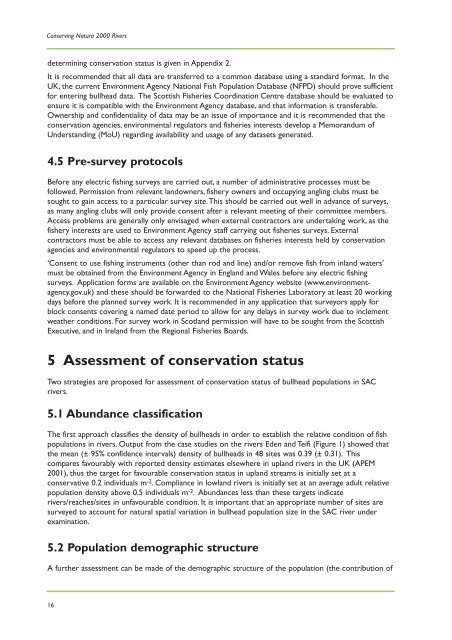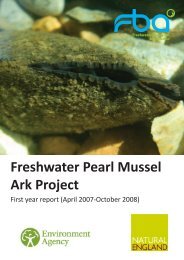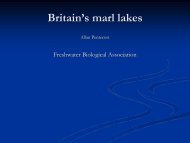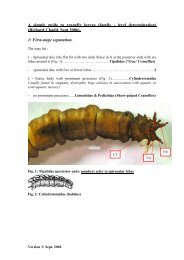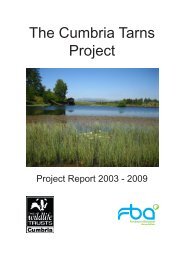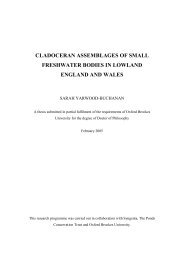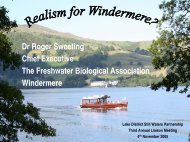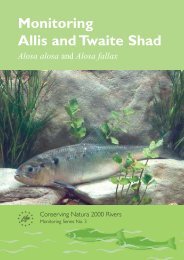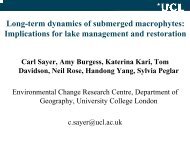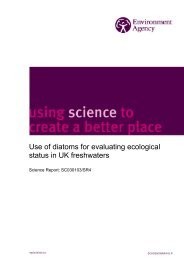Monitoring the Bullhead - European Commission
Monitoring the Bullhead - European Commission
Monitoring the Bullhead - European Commission
Create successful ePaper yourself
Turn your PDF publications into a flip-book with our unique Google optimized e-Paper software.
Conserving Natura 2000 Rivers<br />
determining conservation status is given in Appendix 2.<br />
It is recommended that all data are transferred to a common database using a standard format. In <strong>the</strong><br />
UK, <strong>the</strong> current Environment Agency National Fish Population Database (NFPD) should prove sufficient<br />
for entering bullhead data. The Scottish Fisheries Coordination Centre database should be evaluated to<br />
ensure it is compatible with <strong>the</strong> Environment Agency database, and that information is transferable.<br />
Ownership and confidentiality of data may be an issue of importance and it is recommended that <strong>the</strong><br />
conservation agencies, environmental regulators and fisheries interests develop a Memorandum of<br />
Understanding (MoU) regarding availability and usage of any datasets generated.<br />
4.5 Pre-survey protocols<br />
Before any electric fishing surveys are carried out, a number of administrative processes must be<br />
followed. Permission from relevant landowners, fishery owners and occupying angling clubs must be<br />
sought to gain access to a particular survey site.This should be carried out well in advance of surveys,<br />
as many angling clubs will only provide consent after a relevant meeting of <strong>the</strong>ir committee members.<br />
Access problems are generally only envisaged when external contractors are undertaking work, as <strong>the</strong><br />
fishery interests are used to Environment Agency staff carrying out fisheries surveys. External<br />
contractors must be able to access any relevant databases on fisheries interests held by conservation<br />
agencies and environmental regulators to speed up <strong>the</strong> process.<br />
‘Consent to use fishing instruments (o<strong>the</strong>r than rod and line) and/or remove fish from inland waters’<br />
must be obtained from <strong>the</strong> Environment Agency in England and Wales before any electric fishing<br />
surveys. Application forms are available on <strong>the</strong> Environment Agency website (www.environmentagency.gov.uk)<br />
and <strong>the</strong>se should be forwarded to <strong>the</strong> National Fisheries Laboratory at least 20 working<br />
days before <strong>the</strong> planned survey work. It is recommended in any application that surveyors apply for<br />
block consents covering a named date period to allow for any delays in survey work due to inclement<br />
wea<strong>the</strong>r conditions. For survey work in Scotland permission will have to be sought from <strong>the</strong> Scottish<br />
Executive, and in Ireland from <strong>the</strong> Regional Fisheries Boards.<br />
5 Assessment of conservation status<br />
Two strategies are proposed for assessment of conservation status of bullhead populations in SAC<br />
rivers.<br />
5.1 Abundance classification<br />
The first approach classifies <strong>the</strong> density of bullheads in order to establish <strong>the</strong> relative condition of fish<br />
populations in rivers. Output from <strong>the</strong> case studies on <strong>the</strong> rivers Eden and Teifi (Figure 1) showed that<br />
<strong>the</strong> mean (± 95% confidence intervals) density of bullheads in 48 sites was 0.39 (± 0.31). This<br />
compares favourably with reported density estimates elsewhere in upland rivers in <strong>the</strong> UK (APEM<br />
2001), thus <strong>the</strong> target for favourable conservation status in upland streams is initially set at a<br />
conservative 0.2 individuals m -2. Compliance in lowland rivers is initially set at an average adult relative<br />
population density above 0.5 individuals m -2. Abundances less than <strong>the</strong>se targets indicate<br />
rivers/reaches/sites in unfavourable condition. It is important that an appropriate number of sites are<br />
surveyed to account for natural spatial variation in bullhead population size in <strong>the</strong> SAC river under<br />
examination.<br />
5.2 Population demographic structure<br />
A fur<strong>the</strong>r assessment can be made of <strong>the</strong> demographic structure of <strong>the</strong> population (<strong>the</strong> contribution of<br />
16


